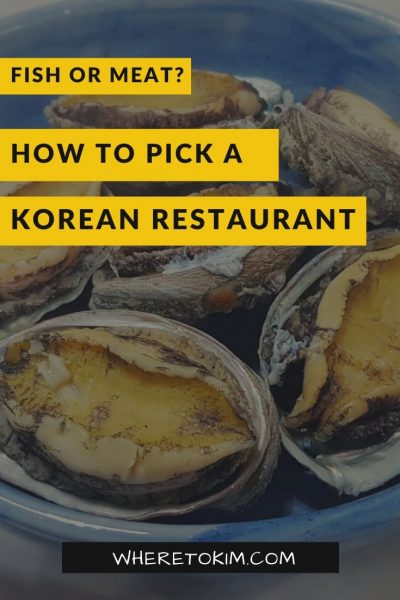Korean restaurants often specialize in one type of food or ingredient. This makes your restaurant choice more important and also more challenging. Read here about this and other things that will surprise first-time visitors choosing restaurants in Korea.
Assume you’re a party of three. One person doesn’t eat fish unless it is fried fish or smoked eel (just to be clear: not me), the other two like both but really want to try the fish dishes they can’t sample at home. It is dinner time. What do you do? At home any restaurant will do; they usually offer at least one meat dish, one fish dish and one vegetarian and/or vegan choice. In South Korea, most restaurants specialize in one or the other. If you’re in a remote area near the ocean, then fish dishes will be in abundance. Other examples of specialized Korean restaurants are: Korean BBQ, Korean Fried Chicken and Kalguksu. Though there are exceptions, namely those few hard-to-find places that sell both meat and fish. This is where the search for a restaurant in Korea comes in.
Negotiating
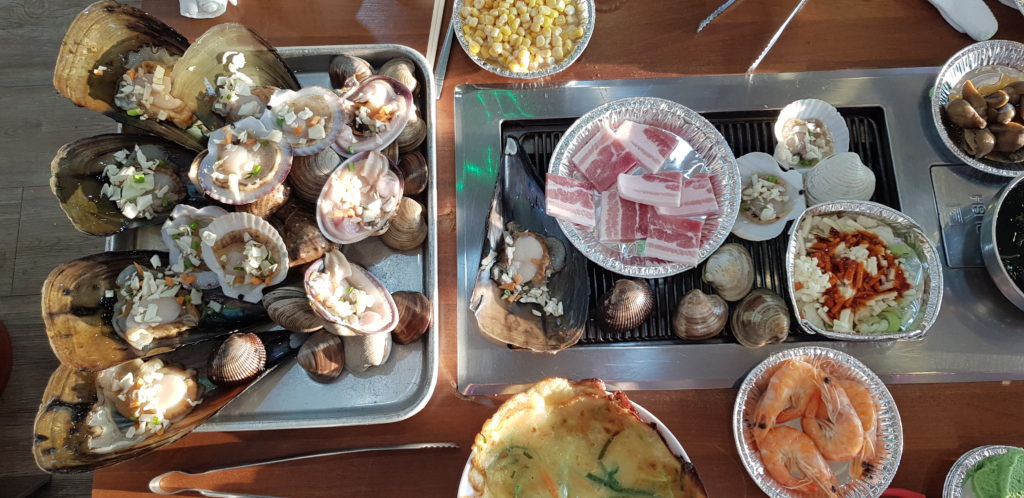
Negotiate the type of restaurant you’re going for with your travel companions. ‘We had Korean BBQ yesterday evening, so let’s go to a fish restaurant tonight.’ Or: visit more meat restaurants while sightseeing far from the coast so you build some credit for visiting more fish restaurants when visiting islands and peninsulas. Fortunately, with all the side dishes you get with a meal, one can easily survive on rice and vegetable side dishes only.
Conversing
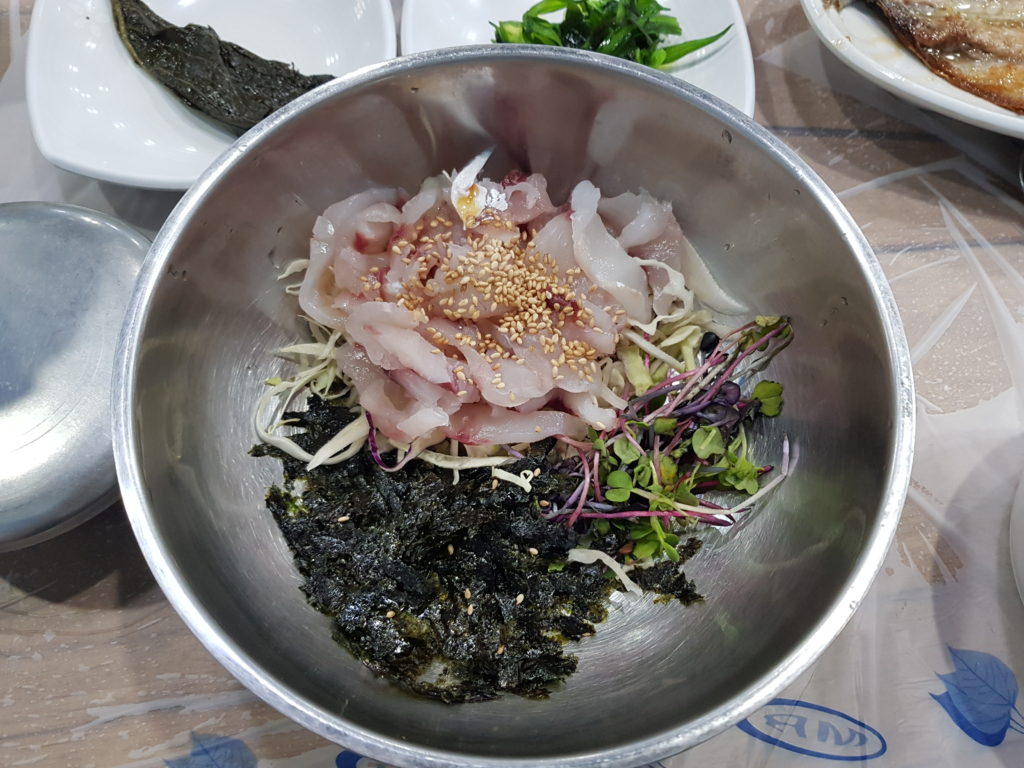
I planned to do better on my South Korea trip this year than I did last year. I practiced my broken Korean that is pretty much only good for ordering food and supplementing my pointing at the menu. I prepared some sentences to ask if they can make a certain rice dish (bibimbap) with rice and vegetables only, leaving the sashimi out.
In the end I didn’t use those sentences but I did ask the following questions:
- Bulgogi isseoyo (is there Bulgogi?; a beef dish)
- Samgyeopsal isseoyo (is there pork belly?)
I gained victory upon victory when they understood what I wanted. That went very different from last year when I could only helplessly stare without the skill to create a simple sentence. I remember mistaking a picture of fried shrimps for tonkatsu (fried pork cutlet), though that must have been wishful thinking.
Research and explore
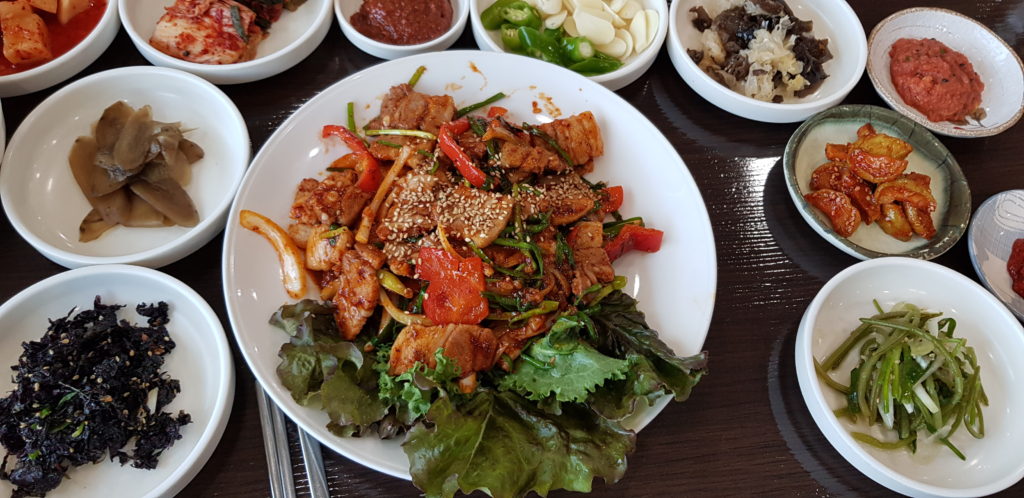
The other part of this year’s plan was to explore using Google maps and KakaoMap, clicking on restaurant after restaurant and looking at pictures of Korean food and menus to see if they have one meat dish on offer in a fish lover’s paradise. When visiting the very south and west of South Korea, so basically spending time on the islands and peninsulas, the food on offer is fish. Plenty of it. Lucky me, unlucky travel companion.
But I found some. There is this restaurant on Jangjado that sells Galbitang (beef bone soup) next to its many shells, sashimi, crab and so on. And this restaurant in Boryeong, where you can grill shellfish next to pork belly. Another success. I marked them as my favorites on the map.
Have you tried Korean Baby Octopus? (Don’t worry: it is dead. The nerve system just doesn’t know it yet.)
When going to a Korean BBQ restaurant near the ocean, restaurants usually offer pork belly (Samgyeopsal) as an add-on menu when grilling shellfish or eel. The same restaurants also hand foreigners a simplified English menu with bulgogi on it but every time we order it they don’t actually have it. Samgyeopsal was always in stock though (in frozen form).
Another Korean dish that is often included next to fish dishes in the menu is Spicy Stir-fried Pork, so see if you can spot it on the menu: 돼지볶음.
Vegetarian and vegan
The real challenge comes when you want to eat vegetarian or vegan, good luck to you! Anchovies in the soup stock eliminate even those dishes that seem tofu only. Rice is safe though and many side dishes are too. (There is plenty of choice for vegetarians and vegans, but as I’m not vegan or vegetarian I’ll let others write useful tips for that).
Korean dessert restaurants

Then the next challenge takes the stage: after succeeding in choosing a restaurant for your main meal, you can select a dessert restaurant or cafe if you want to finish with something sweet. Main courses and dessert are strictly separated. Bingsu (shaved ice cream) is popular nowadays. If you order one each you’ll be the model tourist. After doing it once you’ll order one per two people, like the Koreans do. They’re kinda big.
Korean breakfast restaurants
Finding a Korean breakfast restaurant is in a league of its own: the best restaurants to have Korean breakfast at are the small restaurants that are open 24/7. The challenge is in finding them, as they often have no internet presence whatsoever. Read my Breakfast in South Korea special for tips.
Meal size versus price
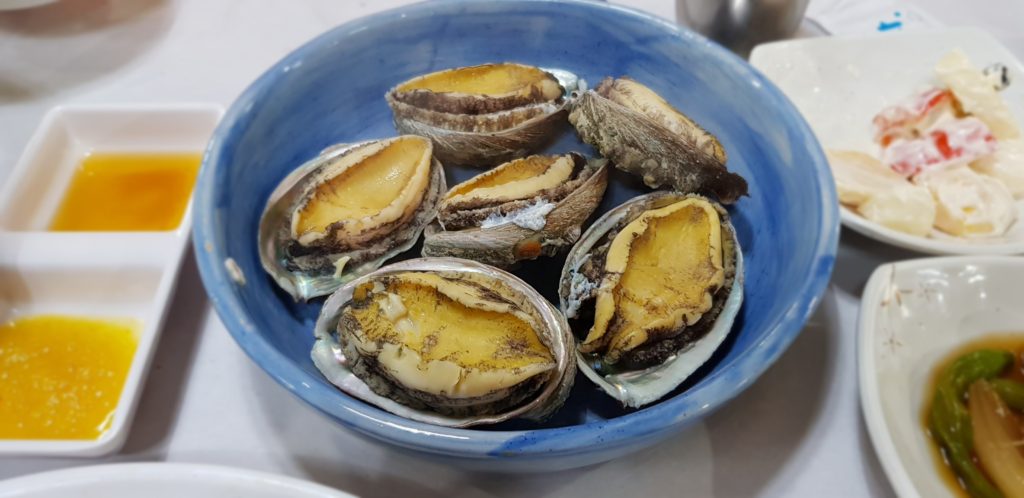
Meal prices are interesting too. If you see something of 30,000 Korean Won or more it’s usually something that feeds two or three people (unless you order expensive food). If you order one each, as 30k is after all a normal per person meal price where I live, you’ll stare and stare at the table and fail to eat it all. Even all the side dishes you want to try seem to come at you.
To summarize
- Choose between fish or meat (Alternatively: don’t travel with someone with a different taste or practice your negotiation skills)
- Switch restaurants for every course
- Share everything
- Be very careful when the price is over 30,000 Korean Won.
Just joking though, you’ll easily get the hang of it in a few days. These are just the things that I didn’t expect when I visited South Korea for the first time. On my second visit, we only ended up in a restaurant without meat on offer once when eating an abalone course in Wando (the beef part of the course was out of stock). There are many places to choose from and unfortunately you can’t try all of them.
Eat Korean food at home
If you can’t wait for your trip to South Korea, then try your hand at cooking Korean food at home!
By now I’m the proud owner of my second batch of Gochujang (red pepper sauce), Doenjang (soybean paste for stew) and Korean Sesame Oil. The Gochujang is essential for making tteokbokki but it is also great to spice up any stir-fried dish or a soup. I use Doenjang for any tofu stew I make and also add it to porridge or a light soup. Sesame Oil is great for seasoning dishes like bibimbap and for your own creative mix of lentils and vegetables.
You can find recipes for Korean dishes in Maangchi’s Real Korean Cooking or online at her website.
